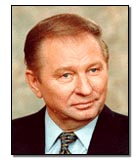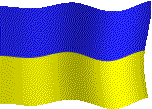Basic Facts about Ukraine
See also new website - Ãëÿíüòå íîâèé âåáñàéò: www.ukremb.ca
|
View full size Maps - EnglishMap - Ukrainian |
 State FlagState SymbolsNational Holidays |
Coat-of-Arms |
National Anthem |
Meet Ukraine - Ministry of Foreign Affairs site Facts, Society, History, Map (UkraineInfo.US) Geography and People Government Ukraine's Main Historical Events Other Information 
|
Geography and People
Territory:
Ukraine is located in southeastern Europe, bordering on Belarus, Russia, Hungary, Romania, Moldova, Poland, and Slovakia. In the south, Ukraine is washed by the Black Sea and the Sea of Azov. Ukraine's neighbors across the Black Sea are Turkey, Bulgaria, and Georgia. The total length of the frontiers is 6,500 km, including 1,050 km of sea frontiers.
Population:
49.5 million (2001)
46% male and 54% female;
35.1 million urban and 16.6 million rural;
density: 87 persons per sq. km.
Ukraine is inhabited by representatives of 128 nations, nationalities, and ethnic groups. Ukrainian is considered mother tongue by 66.3%, and Russian by 31.3%. English is the most popular foreign language.
Capital of Ukraine:
Kyiv
Regions of Ukraine - Administrative divisions:
24 oblasts, 1 autonomous republic (The Autonomous Republic of Crimea (Krym), 2 municipalities (Kyiv and Sevastopol). To view regions, please click on map.

Largest Cities:
|
Kyiv........................ Kharkiv................... Dnipropetrovsk........ Donetsk.................. Odesa..................... Zaporizhya.............. Lviv........................ Mykolayiv................ Luhansk.................. |
2.635 million 1.575 million 1.161 million 1.101 million 1.059 million 887 thousand 806 thousand 519 thousand 493 thousand |
Climate:
The climate of Ukraine is mostly temperate continental. A subtropical Mediterranean climate is prevalent on the southern portions of the Crimean Peninsula. The average monthly temperature in winter ranges from -8° to 2° C (17.6° to 35.6° F), while summer temperatures average 17° to 25° C (62.6° to 77° F). The Black Sea coast is subject to freezing. Precipitation generally decreases from north to south; it is greatest in the Carpathians, where it exceeds more than 1500 mm (58.5 in) per year, and least in the coastal lowlands of the Black Sea, where it averages less than 300 mm (11.7 in) per year.
Terrain:
Almost the entire country of Ukraine is a flat plain, with elevations generally below 350 m. The Carpathian Mountains intrude at the extreme west, and on the southern coast of the Crimean Peninsula the Crimean Mountains are located. The highest point in Ukraine is Mt. Hoverla in the Carpathians, with an elevation of 2061 m. Ukraine occupies only 0.45% of the planet's dry land, but it boasts approximately 5 per cent of the world's total mineral resources
.Inland Waterways:
Most major rivers flow south to the Black Sea; they include the Dnipro River in central Ukraine, the Southern Bug and Dnestr rivers in the west, the Donets River in the east, and the Danube in the far south. The Western Bug flows northward through the western part of the country and joins the Vistula, which empties into the Baltic Sea.
Government
Ukraine
is a Republic. As stated in the Constitution: "Ukraine is a sovereign and independent, democratic, social, legal State."
Official language:
Ukrainian.
Symbols of State:
State Flag, Coat-of-Arms, and National Anthem.
State Power:
State power in Ukraine is based on the division of authority into legislative, executive, and judicial. The Constitution of Ukraine has the supreme legal strength. Laws and other legislative and normative acts are enacted based on the Fundamental Law and must strictly conform to it.
President of Ukraine:
The President of Ukraine is the Head of State, Chief of the Executive Branch and acts on behalf of the State. Since his election in July 1994, Ukraine's President is President Leonid Kuchma.
Verkhovna Rada:
The Verkhovna Rada is the Ukrainian Parliament and the sole legislative authority. It is composed of 450 members.
To connect to the web-site of the Verkhovna Rada of Ukraine click here.Executive Power:
Executive power is exercised by the Cabinet of Ministers as the supreme executive authority, and by a system of local bodies of state executive power.

Judicial Power:
Judicial power in Ukraine is vested in the courts of law. The Constitutional Court of Ukraine is the sole body of constitutional jurisdiction.
Legal system:
Based on civil law system.
Constitution:
1996 Constitution. To see full text of the Constitution click here.
Ukraine’s Main Historical Events
| 5th cent. BC | Scythian settlements and Greek city-states in the south regions of today’s Ukraine. |
| 1st-2nd cent. | Some parts of southern Ukraine are included into the Roman Empire. |
| 5th-6th cent. | Foundation of Kyiv, capital of the Eastern Slavic States. |
| 9th-11th cent. | Formation of Kyivan Rus, a large and powerful medieval state whose territory spreads from the Baltic Sea to the Black and Azov Seas. Dynastic connections with Byazantian empire and European states. |
| 988 | Christianization of Kyivan Rus by Volodymyr the Great, Grand Prince of Kyiv. |
| 1240 | Kyiv is occupied by the Mongols. Cultural centre of Ukraine shifts to the state of Halychyna-Volyn (Western Ukraine), ruled by King Danylo. |
| 14th cent. | Ukraine under Polish and Lithuanian rule. |
| 16th-17th cent. | Development of Cossackdom. |
| 1648-54 | The Great Cossack Revolt. Ukraine gains its independence from Poland. Seeking aid to gain external support for the Revolt, Cossack Hetman Bohdan Khmelnytsky recognizes, in the Treaty of Pereyaslav, the sovereignty of the Tsar of Muscovy and preserves Ukraine’s internal autonomy. |
| Early 18th cent. | Hetman Ivan Mazepa makes, with Swedish support, an unsuccessful attempt to reject the Tsar’s sovereignty over Ukraine. |
| Late 18th cent. | Ukraine loses its autonomy and becomes a province of the Russian Empire. Western Ukraine comes under control of the Austrian Empire (later Austria-Hungary). |
| 1840 | The Kobzar, the most famous work of Taras Shevchenko, Ukraine’s great national poet, appears. |
| 1876 | Russian imperial authorities ban the use of the Ukrainian language in education, publishing, theatre and music. |
| 1917 | As the Russian Empire collapses due to the Revolution, Ukraine asserts its autonomy and creates its own government, the Central Rada. |
| Jan. 22, 1918 | Proclamation of Independence by the Ukrainian People’s Republic. |
| Jan. 22, 1919 | Act of Union of Western and Eastern Ukraine. |
| 1917-20 | Civil War; establishment of soviet power in Ukraine. Western Ukraine becomes part of Poland. |
| 1922 | Ukraine becomes a Soviet Republic within the USSR. |
| 1932-33 | Great famine: Soviet policies lead to an artificially created famine-genocide that devastates the Ukrainian countryside, causing population losses of 6-7 million. Despite strong resistance, Stalin imposes collectivization in agriculture. |
| 1929-53 | Decades of Stalinist repression and purges that decimate supporters of Ukrainian nationhood, especially intelligentsia. Strict censorship enforced, religious life banned, churches destroyed, institutions dissolved. |
| 1939-45 | World War II. Ukraine suffers enormous human and material losses: 8 million killed and 2.3 million sent to Germany as slave labourers. |
| 1945 | Ukrainian SSR becomes one of the founding members of the United Nations. |
| 1960’s-70’s | Dissident movement among Ukrainian intelligentsia. |
| Apr. 26, 1986 | Chornobyl nuclear disaster (70 km north of Kyiv). |
| Late 1980’s | Creation of first Ukrainian political opposition parties and movements. (Rukh, Zeleny Svit). |
| 1990 | Parliament of Soviet Ukraine adopts the Declaration of State Sovereignty. |
| Aug. 24, 1991 | Declaration of Independence of Ukraine. |
| Dec. 1, 1991 | In a national referendum, more than 90 percent support independence. Newly- elected President Leonid Kravchuk becomes Supreme Commander of all armed forces on Ukrainian territory. Ukraine’s Parliament adopts the national flag, anthem and coat-of-arms. |
| 1992 | Ukraine joins the Organization on Security and cooperation in Europe (OSCE). |
| 1994 | The first democratic presidential elections take place: Leonid Kuchma defeats Leonid Kravchuk. The process of radical economic reform begins in Ukraine. Ukraine becomes a participant in NATO’s "Partnership for Peace" program. Ukraine joins the non-proliferation treaty and becomes the first country in the world’s history to destroy its nuclear stockpiles. |
| 1995 | Ukraine becomes a member of the Council of Europe. |
| 1996 | Ukraine’s Parliament adopts a new Constitution. In Atlanta, independent Ukraine is represented for the first time in Summer Olympics, finishing in the top 10. Ukraine introduces the hryvnya, its monetary unit. |
| 1997 | Ukraine and Russia sign a Treaty on friendship, partnership and cooperation, as well as a historic accord on division of the Black Sea Fleet. Ukraine and NATO enter into a special relationship signing the "Charter on a Distinctive Partnership". |
| 1998 | Agreement on Partnership and Cooperation between Ukraine and the European Union enters into force. |
| 1999 | The UN votes in favor of Ukraine’s becoming a non-permanent member of its Security Council in 2000-01. In a presidential election runoff, Leonid Kuchma is re-elected. |
| 2000 | Ukraine’s Parliament abolishes the death penalty. The Chornobyl nuclear power plant is finally shut down. |
| 2001 | Parliament approves Anatoliy Kinakh as prime minister. The Presidents of Georgia, Ukraine, Uzbekistan, Azerbaijan, and Moldova (GUUAM) sign a charter formalizing the alliance of their countries. Pope John Paul pays a 4-day visit to Ukraine. |
| 2002 | Nato Prague Summit - Official Participation of Ukraine -
Parliament approves Ukrainian President's nominee Viktor Yanukovych as Ukraine's PM.
|
|
See also News Archives of the Embassy of Ukraine |
|
Other Information
Currency:
Hryvnya
Exchange rates:
To view current exchange rates for the hryvnya, please click here.
Industry:
Industry contributes more than 40 per cent of GDP and accounts for more than one-fourth of total employment.
Ukraine is a major center for heavy machinery and industrial equipment production, machine tools, large electrical transformers, ships, locomotives, rail cars, passenger and cargo aircraft, agricultural machinery as well as textiles.
It also has a well-developed chemical industry that produces various plastics, tires and fertilizers.
The Ukrainian aerospace and defense industry, which includes more than 500 military enterprises and research institutes, is known for its state-of-the-art technology and production of reliable equipment.
Agriculture:
Agriculture accounts for about 25 per cent of Ukraine’s total GDP and approximately the same percentage of total employment. Mainly due to extremely fertile soil, Ukraine is a major producer and exporter of a wide variety of agricultural products, including sugar, sunflower oil, flax, different crops and dairy products. This sector offers diverse opportunities for foreign investments, especially in the field of food-processing and storage.
See also Embassy of Ukraine article on the 10th Anniversary of Independence: "Ukraine’s Economy: Time to Invest"
Yurii Nykytiuk, Press Secretary of the Embassy of Ukraine
310 Somerset Street West, Ottawa, ON K2P 0J9
Tel. (613) 230-2961, fax (613) 230-2400
E-mail: ukrembassy@on.aibn.com
2004 04 09

